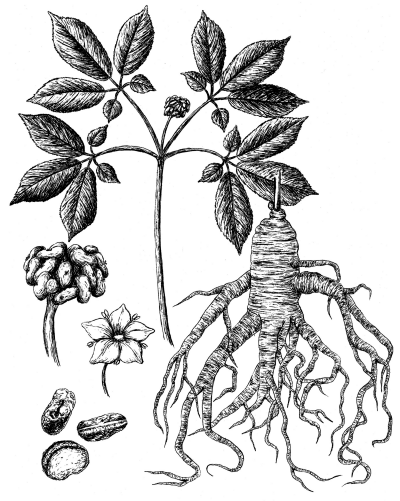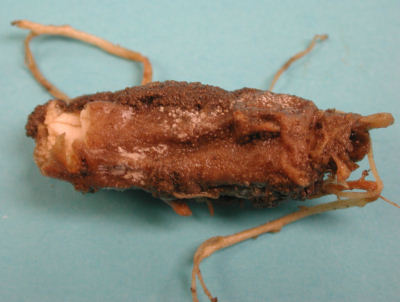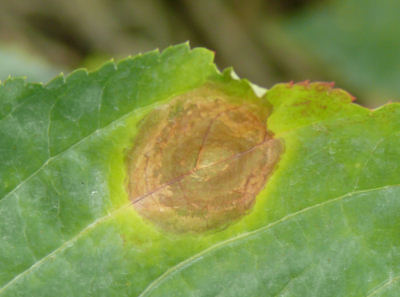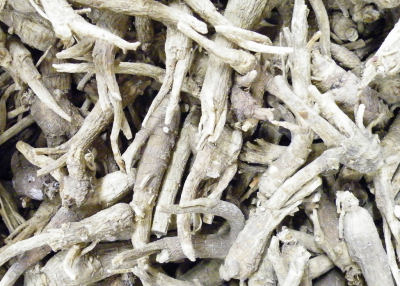Ginseng production
Learn about growing ginseng in Ontario.
Introduction
Ginseng is a slow-growing herbaceous perennial cultivated for its highly valued root as a medicinal herb. It is grown in temperate climate zones, particularly North America and Asia.
Panax quinquefolius, the species grown in North America, differs slightly from the principal species native to Asia, Panax ginseng. Other species of ginseng are cultivated to a lesser extent.
Ginseng is a member of the Araliaceae family, which includes wild sarsaparilla, dwarf ginseng and spikenard. All of these plants can be found in the forests of Ontario. The climate and soils of south-central Ontario are ideally suited to growing ginseng.
About 85% of the ginseng root grown in North America is sold to the Asian market, where there is a considerable distinction between North American and Chinese ginseng based on their medicinal uses.
History
Ginseng is native to the hardwood forests of Eastern North America. Wild roots were harvested by Indigenous people and used in traditional medicines. Ginseng exports began in the early 1700s. Field cultivation began by moving wild roots into protected gardens in the late 1800s.
Wild ginseng is now rare in Ontario and protected by law. The Endangered Species Act, 2007 makes it illegal to plant, harvest, possess, buy, sell, lease or trade ginseng collected from the wild in Ontario without authorization through a permit or agreement under the Act.
Under the Convention on International Trade in Endangered Species (CITES), a permit is required to export field cultivated ginseng roots but not for live plants, seeds or processed root. Exporting wild ginseng root from Canada is prohibited under federal law.
The plant
Ginseng develops from seed planted in the fall. Each autumn, the stem and leaves fall off the plant. In the spring, around mid-May, a single shoot emerges. This cycle continues until the root is harvested. In field cultivation, the root is harvested 3 to 5 years after seeding.
In its first year, the ginseng plant is small, resembling young poison ivy. It has a single leaf with three leaflets at the top of the stem and is 15 to 25 cm tall. In the second year, a single shoot bears two leaves, each with five leaflets arranged in the shape of an open hand. In succeeding years, there are three to four leaves on the plant and occasionally five (Figure 1). The number of leaves increases each year until the fourth year. After that, stems may become thicker, but the actual leaf number rarely exceeds four. Plant height is related to age for the first 3 to 4 years. Ginseng over 3 years old can reach a height of 45 to 60 cm. Under cultivation, ginseng may be taller.

Flower heads develop on a single stalk that arises where the leaves are attached to the stem. The flower head is present at the time of emergence in the spring. Flowering occurs over a period of 3 to 4 weeks in mid-summer on plants 3 years and older and occasionally on 2 year old plants. The flower is an umbel with 30 to 40 blossoms. Flowers open sequentially from the outer edge inward and are self-fertile. Pollination can occur between flowers on a single flower head or between flower heads. Pollination is assisted by bees and insects.
After fertilization, berries form and turn from green to a bright red when ripe. Each berry contains two irregularly shaped seeds, approximately 0.5 cm in diameter and slightly longer than they are wide.
Ginseng has a fleshy branching tap root with a rhizome at the crown. It is on this rhizome that the bud that will be next year’s shoot develops during the summer. This bud remains dormant during the winter months.
Most root growth occurs late in the season. The root of ginseng is also contractile, meaning it shrinks vertically each season. This allows the rhizome, which lengthens every year, to remain under the ground. It also forms concentric wrinkles on the root,which are desirable in the marketplace.
There are no cultivars of ginseng. Field cultivation began by moving wild roots into protected gardens. Further expansion of acreage used seeds from domesticated wild roots. Selection of superior strains has not been achieved with this process.
Site selection
Choosing the right site is the most important thing you can do to ensure a healthy, high-yielding crop.
Soil conditions
Ginseng prefers a moist but well-drained site with high organic matter content and a pH between 5.5 and 6.5. When pH is below 5.5, ginseng is more susceptible to disease and plants are generally unthrifty.
Before seeding ginseng, correct the soil acidity, or pH. Apply lime to soil that is too acid to raise the pH. Private consultants and farm supply outlets can provide prospective growers with soil analysis interpretation and advice on corrective measures.
Drainage is also critical to the health of a ginseng garden. Under wet conditions, ginseng will become diseased, and the roots may rot. Maintaining moist yet well-drained soil can be challenging. Drainage is affected by subsoil structure and compaction. Placing straw mulch on gardens can modify soil moisture, but it is harder to change the natural capacity of the soil.
Many growers allow 2 to 3 years to build up the soil before seeding a ginseng garden. This can be done with the incorporation of organic matter such as plow-down crops or the addition of composted animal manures. Both methods improve the availability of nitrogen. Private consultants and agribusiness professionals serving the ginseng industry can provide advice on nutrient management.
Garden preparation
Garden preparation can begin once a site is selected and pH, nutrition and drainage have been addressed. Before seeding, fumigate soil to reduce the population of nematodes, weeds and disease organisms. Fumigate 4 to 6 weeks before seeding for best results. Effective fumigation requires that soil be worked to “seedbed readiness” with a moisture level of approximately 60% field capacity. Seed ginseng 4 to 6 weeks after fumigation, when all fumigant has dissipated.
Modifying field environment
To cultivate ginseng, modify the field environment to resemble its natural preferences, by:
- forming raised beds
- applying straw mulch
- erecting shade
Raised beds
Raised beds should be designed to promote good air circulation and surface water drainage. Before seeding, raised beds should be:
- 22 to 35 cm high
- 1.5 m wide
- have a 30 cm gutter on each side
- have approximately 1.8 m between the centres of the beds
Maintaining these parameters can help keep disease at manageable levels. Orient beds so that surface water can drain out of the garden, preferably in the same direction as the prevailing wind.
Mulching
After seeding, cover beds with 5 to 10 cm of straw mulch — about 28 large (150 cm diameter) round bales per acre. After the second year, half as much straw should be added again. Mulch modifies both soil moisture and temperature. In winter, mulch prevents temperatures from dropping below the freezing point of the roots (around –10°C). In summer, mulch keeps soil temperatures 5°C to 10°C below that of an open grassed area. Mulch also prevents excessive moisture loss from the soil. Soil moisture under mulch can remain near 60% field capacity throughout the season. Irrigation may be necessary in very sandy soils, but it is not routine.
Shade
Ginseng must be grown in 70% to 80% shade. If light intensity exceeds this level for any length of time, ginseng will senesce (age) and die. In the spring of the first year before the ginseng has emerged, erect shade structures of either wooden lath shade or polypropylene cloth shade on wooden or metal posts, 2.4 to 3.6 m high. The cost of erecting a shade structure varies depending on the material used. Remove shade wholly or partially each autumn after the plants have senesced and the leaves turn colour and fall. Replace the shade in spring as plants emerge. Both wooden lath and cloth shades are reusable.
Seed handling
Berries containing seeds emerge primarily in gardens 3 years and older (Figure 2). Pick the berries when they are ripe. At this point, the ginseng embryo in the seed is immature and very small. Before it can germinate, the seed must undergo stratification, a maturation process that lasts from 16 to 22 months. Harvest berries by hand. It may be necessary to harvest several times because the berries ripen sequentially.

After picking the berry, remove the pulp, either by a natural fermentation process or by mechanical depulpers. Wash and surface-sterilize the depulped green seed and mix it with an equal portion of clean, coarse sand. Always keep the seed moist after depulping. If the seed dries for even 20 minutes, the embryo can begin to deteriorate and lose its ability to germinate.
To stratify the seeds, place the seed/sand mixture in seed boxes and bury it in the soil until late the following summer. When digging out the seedboxes, separate the seed from the sand, wash it, surface-sterilize it and keep it moist until planting.
Seeds can also be stratified above ground in temperature-controlled chambers. This reduces the chances of contaminating the seeds with soil-borne, disease-causing fungi.
It is important to store stratified seed between 15°C and 20°C before planting. If seed is stored at temperatures that are too cool, it becomes dormant, and emergence may be reduced. When this happens, seedlings can emerge in the garden’s second year, which results in considerable variation in root size.
If seed is stored at temperatures that are too high, the seed will decay.
Seeding
Spread seed on prepared beds. Seeding equipment ranges from simple seed boxes to sophisticated air seeders. Some growers offer custom seeding services for those who do not own their own equipment.
Seeding rates
Seeding rates vary from 90 to 145 kg/ha. There are approximately 17,600 ginseng seeds per kilogram.
Some growers seed at higher rates as a means of overcoming the poor germination of ginseng — 60% to 70% germination is not uncommon. However, seeding at higher rates does not necessarily result in better roots and higher returns.
The value of ginseng roots is affected by their shape. Root shape is determined in the first 2 years of plant life. Research has shown that seeding at low rates of 45 kg/ha can produce roots more than twice as heavy as seeding at high rates of 140 kg/ha. In the same study, the difference in total yield was only 28% more for the denser planting. If long, narrow roots are more than 28% lower in value than chunky root, the increase in total yield will not offset the lower price of the small roots.
Ginseng cannot be produced organically at commercial seeding rates. To grow ginseng without the input of disease control chemicals, do not exceed a seeding rate of 45 kg/ha — 22 kg/ha is preferable. Root disease can still occur at these rates, but cultural practices can control its spread better.
Production challenges
Environment
Ginseng is highly sensitive to environmental conditions. Both heat and drought adversely affect ginseng. Sites that are too wet suffer from root disease, which can drastically reduce yields. Drought and heat leads to flower abortion and consequent reduction in seed set. Heat can bring about stress-related leaf responses such as papery leaf spot. Lack of soil moisture leads to reduced root weight. Exposure to direct sunlight leads to the death of the above-ground portions of the plant. Gardens with poor air flow will experience leaf and head blight diseases.
Climate modification is the only means of addressing soil moisture and both soil and air temperature.
Ginseng is affected by air pollution. It is moderately sensitive to ozone and sensitive to sulphur dioxide. Sulphur dioxide damage, which occurs most frequently in the spring, appears as bleached areas on the leaf tips or bases.
Diseases
Root diseases limit the yield of ginseng. Losses in yield from 30% to 60% are not uncommon. Some root diseases affect root shape and quality. Serious diseases rot the root, destroying it (Figure 3). These diseases are caused by fungi found in soil.

Several foliar blights and seed-blasting diseases exert continual pressure on ginseng gardens throughout the season (Figure 4). These diseases may reduce seed production and root weight, but they rarely cause root loss. The fungi that cause these diseases are present in air currents. Gardens need protection from the time they emerge until they begin to senesce.

Insects
Insects in ginseng do not typically limit yield or affect root quality. In sites with a high number of grassy weeds, cutworms may be a problem. European chafer grubs can also live on the grain crops used to hold down the straw in the first winter after planting. They can cause damage to ginseng roots when the grains are killed off the following spring.
Leaf rollers may invade ginseng gardens, but little is known of the effect of these insects on ginseng yield. They forage from rolled leaf nests throughout the day and are usually attracted to older gardens and those near forested areas.
Pit scale attaches to the stem and petioles, causing them to become distorted and twisted. A plant normally 60 cm tall will twist down to 15 to 20 cm in height. This insect is found infrequently and its effect on the crop is unknown.
Other pests
Slugs can be a problem in the spring. The straw mulch creates an environment favoured by slugs. Slugs feed on shoots and shallow roots, sometimes causing significant losses. Slug damage occurs most frequently near garden borders.
Mice will occasionally invade a garden. The straw mulch provides protection from natural predators and mice will tunnel along the garden surface under the straw. These rodents will chew off stems and occasionally eat roots at the soil surface. Mice often move into ginseng gardens after nearby field crops are harvested in the late summer or fall.
Root and harvest handling
Harvest ginseng using modified potato diggers. Before roots are dug, remove the shade structure and scrape the bed surface clean of straw and plant debris.
After the digger has passed over the garden, remove roots on the soil surface by hand and place them in baskets. Handle roots carefully to avoid bruising or breakage. Several passes over the garden may be necessary.
Fully automated digging equipment is available for purchase, lease or contract digging.
Refrigeration
Store the washed root under refrigeration for 4 to 6 weeks. Refrigeration improves the roots appearance and reduces the risk of heat damage during the drying process. Before curing, wash the root in a tumble washer drum to remove excess soil particles.
Drying
Ginseng root is usually sold as dried root (Figure 5). Dry roots in kilns designed to provide proper airflow and temperature control. Place roots in shallow trays and rotate the trays several times during the drying process to ensure that roots of different sizes and shapes are dried evenly. A properly dried root breaks easily and has the right surface texture and resilience.

Packing
Pack dried root in cardboard barrels lined with plastic bags in 45 kg lots. Buyers prefer a consistent mix of pencil and chunky roots in each barrel, but no grading is done beyond that. Further grading of the root takes place in warehouses at shipping destinations.
Many experienced growers with large facilities offer custom refrigeration and drying.